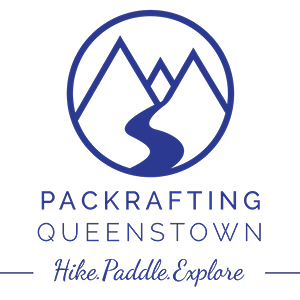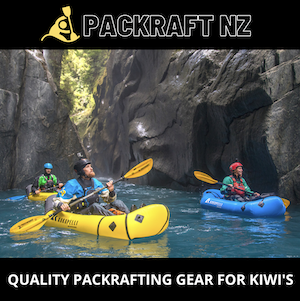The mighty Karamea
The Karamea has been a favourite with fly-in rafting and kayaking parties since before the 1990s. Many of these groups opted to walk in, meeting their boats and extra food after several days of tramping. More recently, packrafters are starting to discover this magnificent loop, following (literally) in the footsteps of the pioneering paddlers. Its fantastic combination of qualities makes it a classic advanced trip: long, remote, scenic, and difficult.
View Larger Topographic Map
Flow is everything on the Karamea
In ‘normal’ flow conditions, the whitewater is generally characterised by huge lazy pools filled with big trout, punctuated by sections of continuous, steep, and serious rapids.
But the Karamea is a west coast river, with steep valley sides, a significant catchment, and a respectable gradient. So when it rains, the river quickly transitions from just difficult, to extreme, then onwards to terrifying.
The gauge is “Karamea River at Gorge”
According to a variety of sources, including some professional raft guides, about 1m on the guage is the optimum flow. Looking at the history of flows, 1m is roughly the residual median flow, once the storms have drained out. Much below that shows a drought on the coast! Looking at the history of flows, the storms can be pretty regular, and it doesn’t take much rain to push the rapids beyond the skill of most paddlers.
- 0.9-1.1m Expect a 6-8 day round trip, with continuous sections of grade III up high, some very munchy sections of IV+, some V (which most portage) in the middle, and a solid IV gorge to finish.
- 1.3-1.6m is high flows for seasoned raft and kayak teams who are competent on big water IV/IV+.
- 1.6-2m is when the lower gorge becomes V/VI.
- >2m is flooding. Continuous grade V through most of the river, with plenty of VI just for fun. Any sane person will be sitting in one of the huts reading a book.
What does this mean for packrafters?
You need to pick your weather and flow window carefully, and have the time/food to sit out any unexpected rain. Below Karamea Bend there are no easy walking escape routes, and even above the bend, side creeks can render the track impassable.
As anyone who ought to even consider the Karamea knows, the difference between 1.1m and 1.3m isn’t just 15% (ish) extra water. (If you don’t understand why, it’s probably a good sign this isn’t the trip for you)
The description on the Whitewater NZ Riverguide website is more indicative of a low water (<1.1m) trip, and some who know the river well (at all levels) suggest the description under-grades some rapids, and under-sells the seriousness of the trip. Take from that what you will.
A trip report at optimum flow
What follows is a trip report at optimum flows with a competent team. It is a great indication of how the trip can go when levels are great and rain events don’t sneak up on you!
The lines on the topo map are indicative only, generally showing the maximum grade for a section at low flows.
And as the writer says, “if you need a rapid-by-rapid description of the river you probably should be building some more skills before setting out.”
View Larger Topographic Map
A week in the wild
Words and pictures by Kelvin Montagu & Liz Saunders.
Our South Island summer of paddling culminated in a seven-day trip on the West Coast’s Karamea River. Winding through 100 km of the Kahurangi National Park this was a great mix of tramping and paddling. It’s why we packraft.

I would rank it up there with Tasmania’s Franklin River for the varied landscapes and length and paddling intensity. A trip of this length tests your mental toughness. Each day you must get up and face the challenge of the river. Even if the weather is shitty or you are sore and bruised from the previous days. It’s also remote. Once you are on the river it’s pretty much the only way out.
Liz and I teamed up with locals Neil Silverwood and Lauren Kelley for a trip I had long had my eye on. This trip is one where you want a solid crew, its remote, there is a lot of whitewater, and the limestone creates many hazards. Not a nice place to swim.
Also, the weather window must be carefully chosen as the Karamea River drains a lot of step country. Some inclement West Coast weather can send this river to ridiculous volumes. Our trip over Easter (31 March – 6 April 2021) timed it well with the river running at just over 1m (around 50 m3/s).
The trip stats
- 28km of walking over the 1,100m Little Wanganui Saddle.
- 65km of paddling with 3 major portages and a few “optional” ones i.e. even the chicken run was pretty gnarly.
- River gradient 485m drop over 65 km at a gradient of 7.5m/km
The days
- Road end to Belltown Manunui Hut (half day)
- Up and over Little Wanganui Saddle to Taipo Hut
- Taipo Hut to Trevor Carter Hut, (half day) then paddle to Thor Hut (long-half day with portages)
- Thor Hut to Crow Hut
- Crow to Roaring Lion Hut
- Roaring Lion to Greys Hut (long day. Big portages, long flatwater sections and rapids)
- Greys Hut to road end (half day)
The shuttle
The takeout is on Umere Road, at a Fish & Game access point. There is good parking here.
Only 22km away is the start of the Wangapeka Track where you begin.
The tramp
We accessed the upper Karamea River via the western end of the Wangapeka Track. There are lots of other options to access the river and tributaries – grab a map and explore.
With all the crew on the West Coast, starting and finishing on the West Coast side made for a short car shuffle, only 22km. It also meant we could meet Lauren and Neil for lunch and a final gear and weather forecast check at Karamea’s world-famous Vinne’s Café. Definitely worth a pre- and post-trip visit.


The tramp followed the Little Wanganui River up to Manunui Hut. We got to enjoy lush lowland West Coast rainforest as it’s meant to be – in the rain. The Karamu bright orange berries were spectacular against the lush greens of the forest and contrasted with the brilliant blues of the occasional sky-blue mushroom.

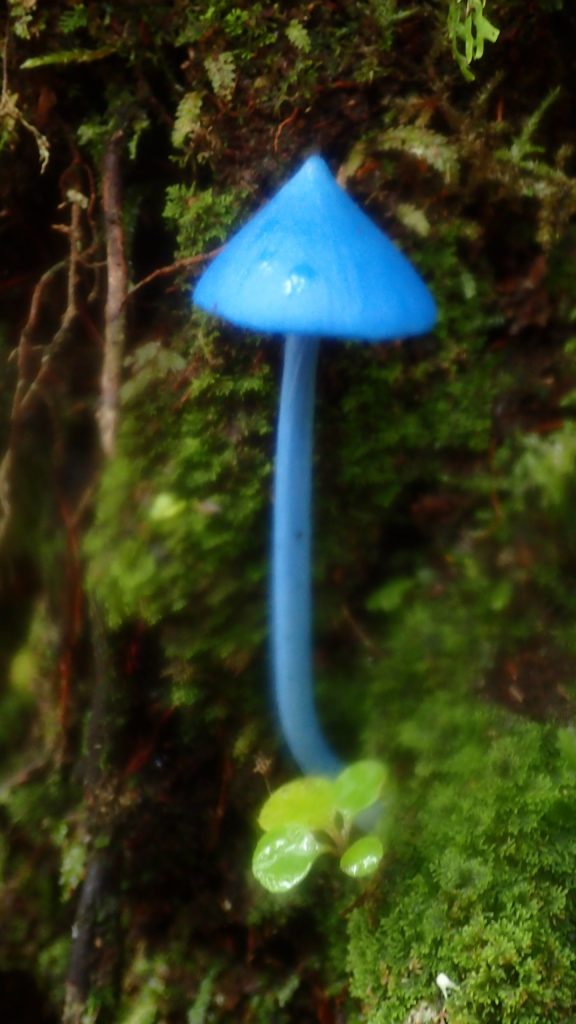
The major climb and descent for the trip was going over the 1,100m Little Wanganui Saddle into the Taipo catchment. This was a bit of a grunt with full packs. We had fantastic weather giving us a good look at the pass from a distance.

The climb took us up through temperate rainforest giving way to beech dripping in mosses and lichens and finally mountain cabbage trees and Dracophyllums. From the top of the saddle we had good views south to the Allen and Radiant Ranges, rugged country.
A careful descent into beech forest took us down to the upper Taipo River and hut.

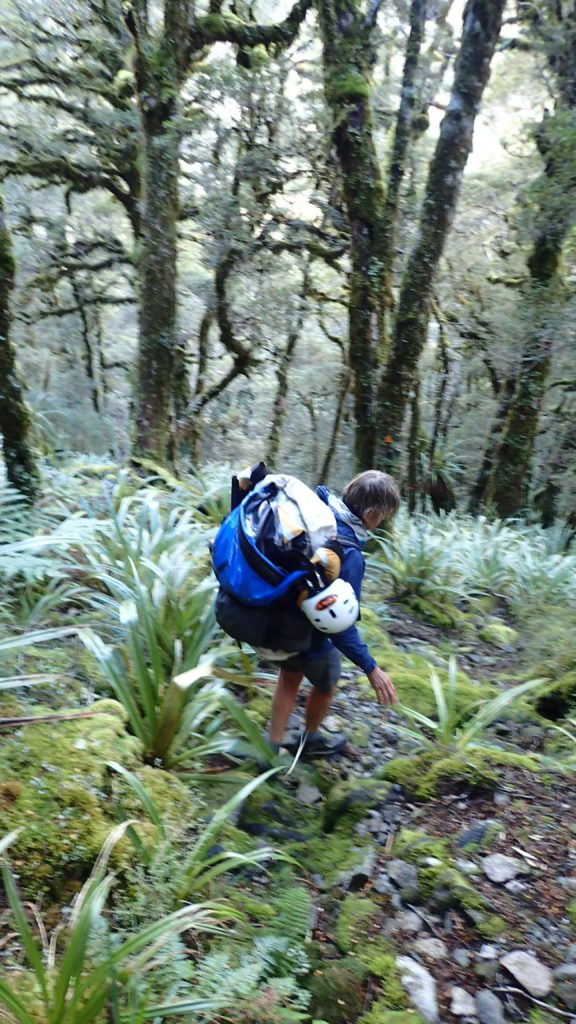
The following morning, we followed the Taipo River down, occasionally scouting put in points. The Taipo River level was a bit low but there were some lovely looking gorge sections. To paddle this section would require some reasonable rain which would make for some challenging paddling further downstream. We ended up walking through to Trevor Carter Hut where we transitioned from tramping to paddling.

The River
The Karamea River drains Kahurangi National Park, New Zealand’s second-largest national park. The river cuts its way down through layers of limestone and granite. While a West Coast river, the Karamea doesn’t have the same feel as rivers further south, where every hour you walk up a river seems to increase the grade by one. Instead, the upper reaches are lower grade than below Roaring Lion (the largest rapid). There, the gradient quickens, and the flow is boosted by some major tributaries including the Leslie, Roaring Lion, Ugly and Kākāpō rivers, which all have packraft potential in their own right.
The limestone is what gives the Karamea its character and sets it apart from your usual West Coast river. But judging from the slips, limestone clearly doesn’t like earthquakes. That did not stop Neil from trying to convince us that it is perfectly safe to be in a limestone cave during an earthquake. Sure!
The limestone also creates many river hazards such as sieves and undercuts. With the limestone poorly consolidated, the river is frequently rearranging the rock in flood, especially in the bottom sections. Not a nice place to swim and a real need to treat each descent as a first.
Major earthquake slips block the river. Two caused by the 1929 Murchison earthquake above Thor Hut and an older block up which created Roaring Lion rapid. Above the block-ups are lakes and while these give you more time to enjoy the landscapes, always in the back of your mind is that the river gradient must be maintained. Scouting the limestone block-ups is a good idea.
The two slips above Thor Hut have created two quite brutal portages, not long enough to deflate and walk around but long enough to be hard work. In my love-hate relationship with my TiZip, this is the hate part. Carrying boats fully loaded on the inside, over slippery, sharp limestone for hundreds of meters is hard work. This is when I miss my old-school packraft: slipping on the pack and carrying 4kg of mostly air is so much easier for longer portages.


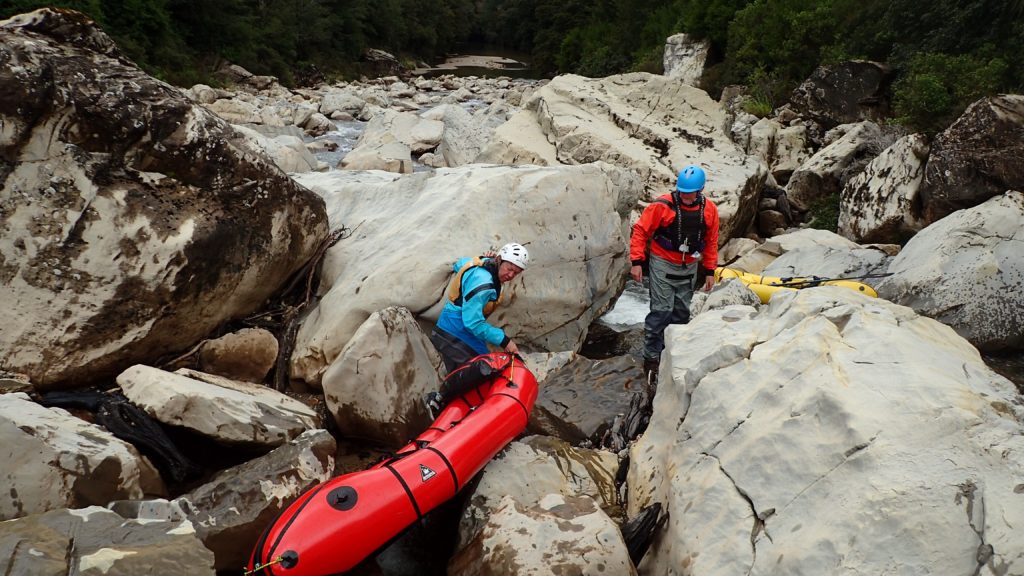

The whitewater in the granite sections is fairly continuous boat scoutable grade III, with the occasional surprise at the bottom. These sections are characterized by granite boulder gardens with some delightful little gorges along the way.
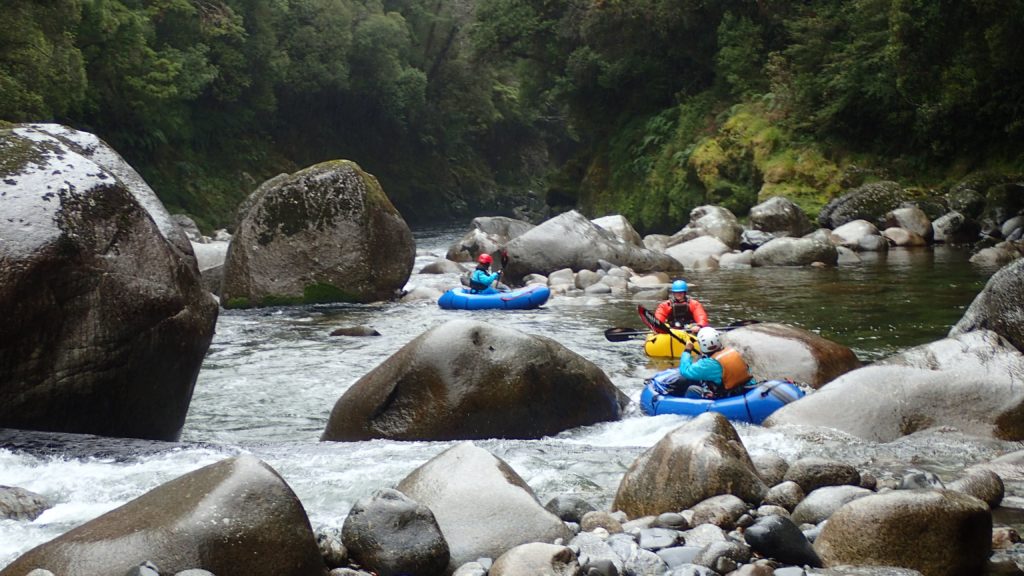
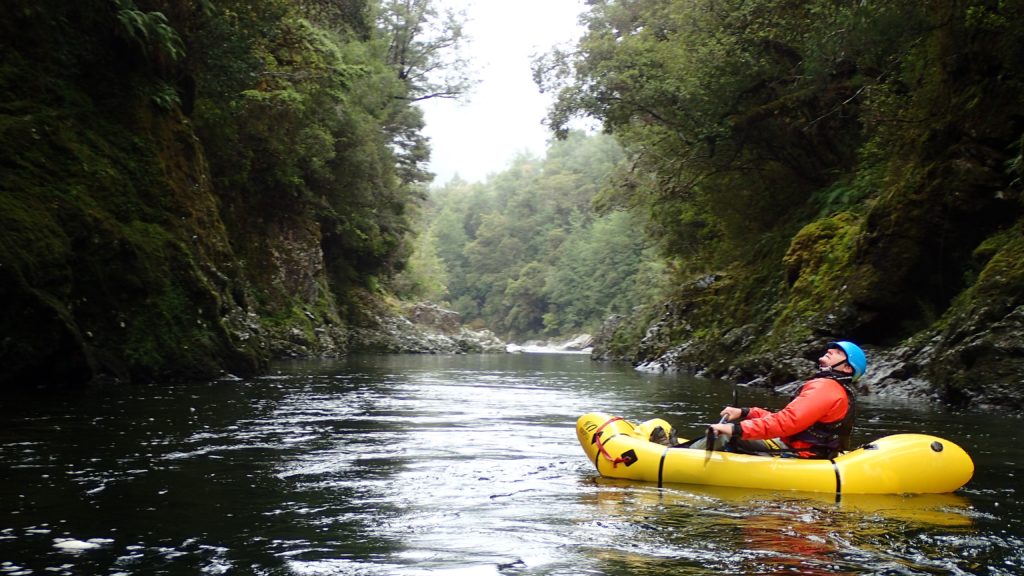
Liz and I hadn’t seen this many whio pairs in years, a reflection of the hard work DOC put in to reduce predators in the lower catchment.
A major fixture of the landscape in the lower reaches is the Garibaldi Ridge with the Pyramid at the highest point. The ridge was slow to show itself with clouds and showers being part of nature’s own landscape reveal party. This limestone feature is largely unexplored, and we could see Neil eyeing up ditching the boat and going caving.


Below the long Roaring Lion block up (we portaged river left and deflated and packed our gear) the river grade and volume increased. Depending on your crew and the water levels, expect a number of portages as even the chicken runs can be gnarly.
This is when the love part of my relationship with my zipper kicks in. Having the extra weight and lower center of gravity really helps to maintain your line in bigger water and when punching through bigger features.
If you need a rapid-by-rapid description of the river you probably should be building some more skills before setting out.
The Karamea River is remote and surprisingly not packrafted that often. From the hut books it looks like roughly one party a year paddle the Karamea. There are lots of options and side trips to explore.
Scenes from the action…

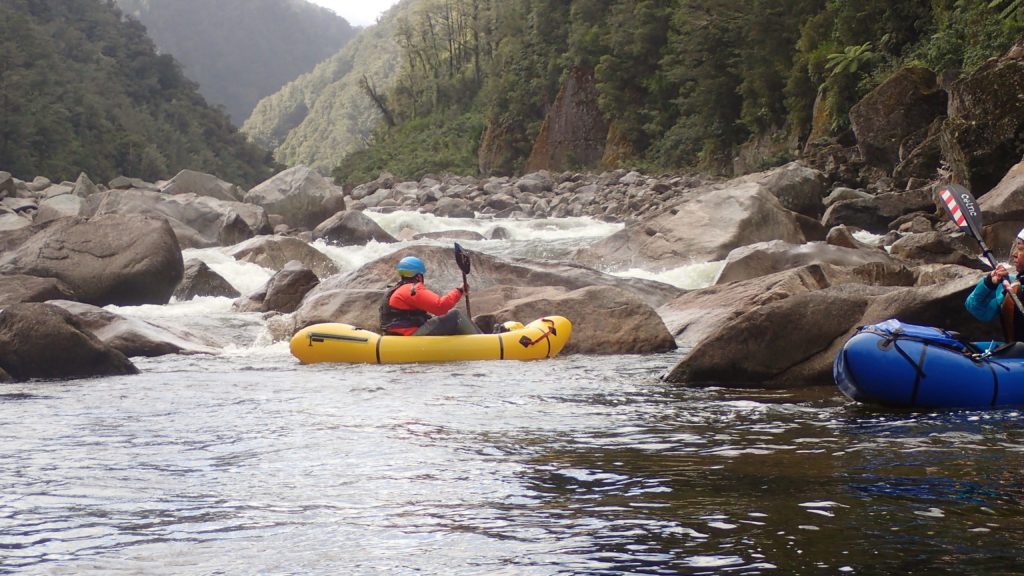



Scenes from the scenic…
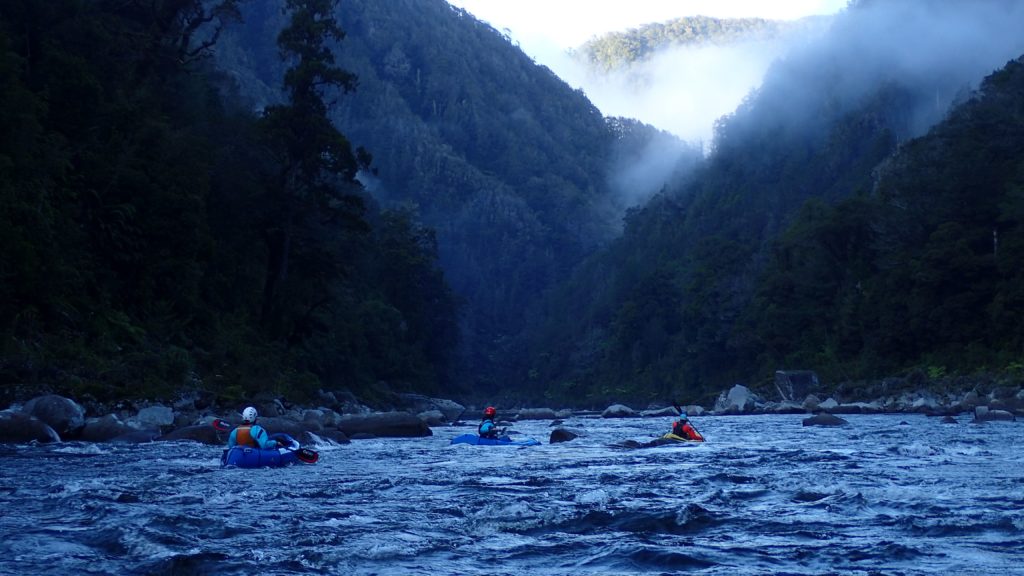


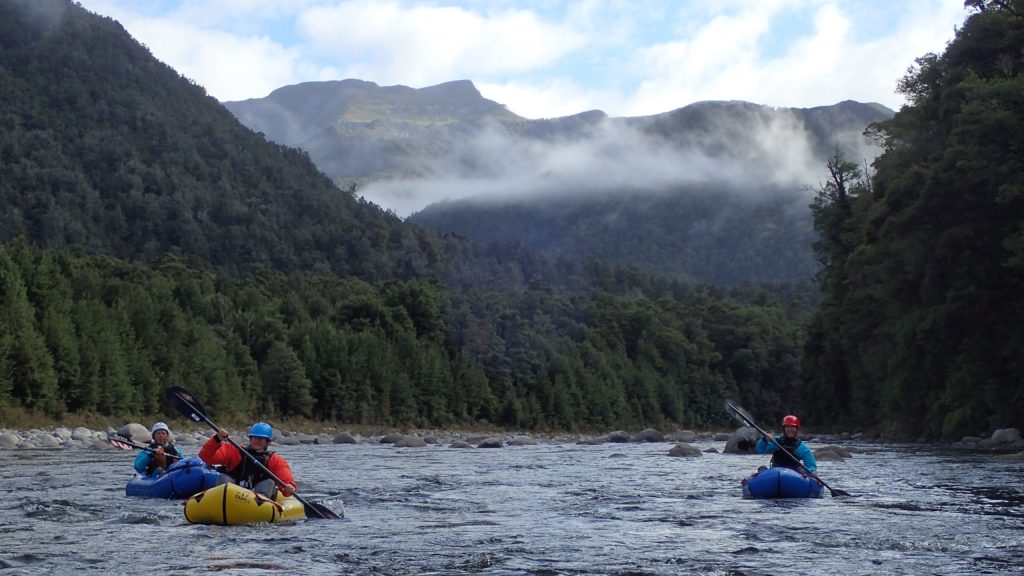


The huts
Despite it being a reasonably remote area, I couldn’t get over the number of huts – a reflection of the old NZFS hut building competition with their national park rivals?



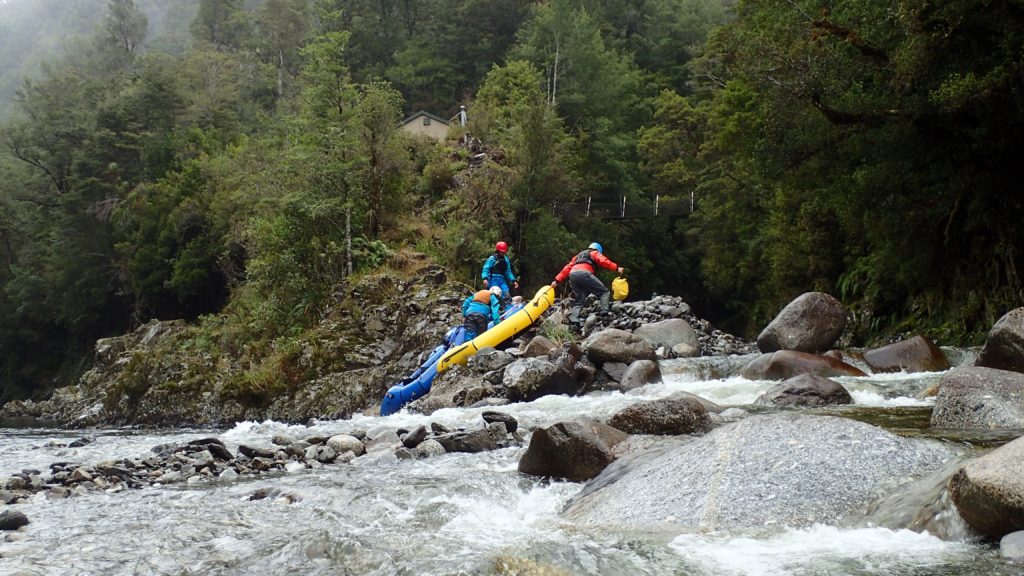
Across the six nights out we managed to stay in six huts Manunui, Taipo, Thor, Crow, Roaring Lion and Greys – and still we managed to paddle/walk past 4 huts. Even by NZ standards there seemed an abundance of huts.
The huts ranged from Thor Hut, which was an old-school NZFS six-bunker. These small huts were comfy but always came with a worry that they would be full of tramper and/or hunters. The more modern DOC huts were very luxurious and very empty.
Despite spending all nights in huts over the Easter period we saw nobody in the huts or on the river.
Thankfully Lauren had done a great job picking out our hut hops as we had no tent and had jettisoned the emergency fly to save weight.
Thanks to Neil and Lauren for sharing their knowledge of this stunning region with us.
Happy paddling.
